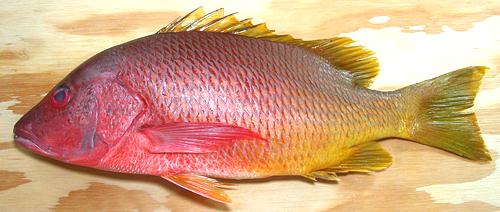 [Yellow Pargo (Sports fishing); Pargo amarillo, Huachinango (Spanish);
Lutjanus argentiventris]
[Yellow Pargo (Sports fishing); Pargo amarillo, Huachinango (Spanish);
Lutjanus argentiventris]
This true Snapper is found in the Eastern Pacific, from Southern California (just a little above the Mexican border), south to Peru. It can grow to 28 inches and 28 pounds, but the photo specimen was 18-1/2 inches and weighed 3 pound 8-3/4 ounces. Yellow Snapper is IUCN Red List rated LC (Least Concern). Aquaculture is in experimental stages.
More on Snapper Family.
The flesh is off white with a darker streak for most of the length, The dark streak is slightly different in flavor and texture, but not enough to be really noticeable. The flavor of this fish is enough for fish lovers but not so strong as to deeply offend those who prefer their fish white and light. This fish does not flake easily but is easily broken up on the plate.
Buying: Yellow Snapper is not a common fish here in Southern California due to its restricted range, though aquaculture is being developed. It's a "buy it when you see it" fish. The photo specimen was purchased from a Philippine fish market in Los Angeles (Eagle Rock, actually) for 2015 US $4.99 / pound.
Cooking: Due to large size and skin shrink, this fish should be cooked as skinless fillets. Fillets hold together well enough that pieces up to 6 inches long can be poached and served without breaking up. If you use it in soup, put it in for the last 10 to 15 minutes.
Scales: The scales are large, hard and have good adhesion, so they take some effort to scrape off, and fly about quite a bit. Some will capsize and have to be picked off with long nose pliers.
Cleaning: This fish presents no particular problems in cleaning, but the gills pull very hard and will have to be cut away with kitchen shears.
Fillet: This is a very easy fish to fillet with easy to follow bone structure. There should be almost no flesh left behind, except in the head. I remove the head before filleting. Tilt the knife to get under the gill covers to get as much flesh as possible. There will be a couple small bones you'll need to cut with kitchen shears, and then the backbone.
The rib cage looks easy to follow, but when I get to it I just cut the ribs away from the backbone with kitchen shears and pull them from the fillet using long nose pliers. They pull a little hard, but cleanly, except the last one or two, which pull quite hard and take a little flesh. There is a row of nasty centerline spines for the length of the body cavity, and these need to be pulled.
Skin: The skin has no strong or "off" flavor, but it is tough, shrinks strongly, and does not let go in during cooking. The skin is moderately thick, but very tough, so fillets can be skinned easily using the long knife and cutting board Method. The skirt is meaty and quite usable, but with a fillet this wide it is best to cut it off and skin it separately. The skirt weighs about 1-3/8 ounces from 13-3/8 ounce fillet (10%). The skins should be included with heads, bones and fins for making stock.
Yield: A 3 pound 8-3/4 ounce fish yielded 1 pound 10-3/4 ounces of skin-on fillet (47%), and 1 pound 6 ounces skinless (43%). This is a fairly decent yield.
Stock: The head, bones and fins and skins make a nearly clear, medium light and very usable soup stock. There is a fair amount of oil, which should be removed - use your gravy separator. For details see our Fish Stock page.
sf_snapywz 150430 - www.clovegarden.com